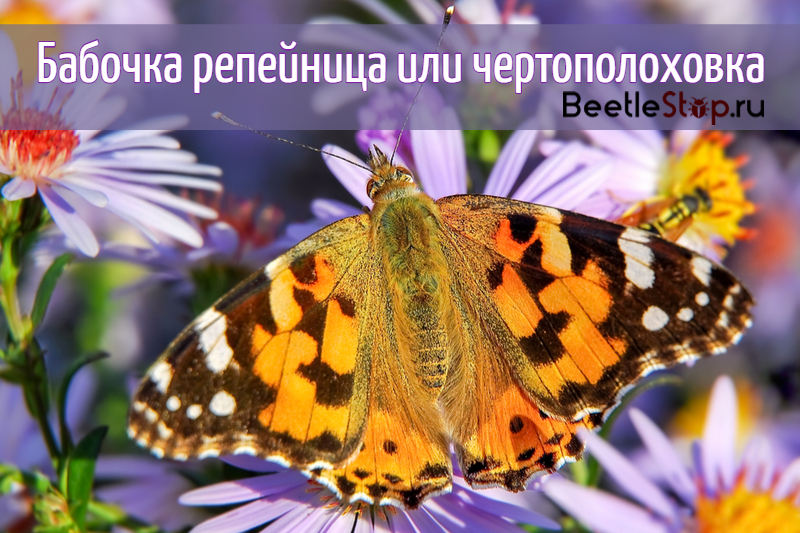Butterfly burdock - migratory insect
Butterfly burdock is very similar to one of its neighbor - urticaria. They are painted about the same, but our today's heroine is a little lighter and has dots on the rear ends of the wings.
These differences are clearly visible if you look at the butterfly burdock in the photo.

Biological Characterization and Description
Name and place in classification
The burdock is a day butterfly of the Vanessa genus of the Nymphalids family. In Latin, her name is Vanessa cardui, and we have the names: “thistle” and “thistle uglary”.
Our help! The Latin name for the thistle is Carduus.
Description
The length of the thistle exceeds thirty millimeters, the wingspan reaches up to 65 millimeters. The description of the butterfly of the lady of throat will continue with the story of its coloring. The body and wings are painted in different shades of orange: from grayish to bright brick.
Symmetrical black and white spots stand out against the bright background of the orange wings. Their intensity decreases as they move toward the back. On the front is a black and white border, on the back are individual dots.
In female lady boomers, sexual dimorphism is not expressed: males and females are almost indistinguishable.
Spread
The habitat of the thistle butterfly is very extensive. Only in the countries of South America and in Antarctica it is impossible to meet them. The northern boundary of its distribution extends to the tundra. But in such high latitudes the thistle does not breed, for this it migrates south.
It is interesting! According to Wikipedia, the thistle woman sometimes flies to the northern islands: Iceland, Svalbard, Kolguyev.
As for the choice of place of residence, thistles prefer places overgrown with weeds:
- roadsides;
- forest edges;
- margins of fields;
- garden and summer cottages;
- mixed meadows;
- banks of water bodies;
- slopes of hills and mountains.
Reference! In altitude, burdock rise to a level of 2.5-3 kilometers above sea level.
In any case, thistle butterflies prefer sunny places, avoiding damp and dark places.
Fodder plants
To feed the caterpillars of the burdock, various weeds are mainly chosen:
- thistle;
- burdock;
- yarrow;
- stinging nettle and dioica;
- coltsfoot;
- Buttock field.
Attention! In the southern regions, during particularly hot years, thistles can affect tomatoes, eggplants, cultivated soybeans, and melons.
Adult insects, adults, feed mainly on nectars of flowering plants. In your garden, you can see beautiful butterflies of this species on cosmeas, asters, and scaffolds.
Migrations
Butterfly thistles are very good flyers. Before migration, thistles gather in large flocks, sometimes reaching more than a thousand individuals.
There are only two directions of migration: in the spring, thistles fly from North Africa to Europe, in the fall - in the opposite direction. The same seasonal flights are observed in Asia and North America.
Reproduction and development
Like all other butterflies, ladybugs are insects with a complete transformation cycle. This means that in the process of development the thistle goes through such stages:
- egg;
- larva, or caterpillar;
- pupa;
- adult, adult insect.
Butterflies hibernate only at positive temperatures. This occurs in the southern regions, and in the middle lane before winter, insects of this species leave in the pupal stage. Adult insects accidentally affected by freezing temperatures inevitably die.
Thus, the years of butterflies stretch in time depending on the region of habitat: in the middle lane, this occurs around the middle or end of June. After mating, the butterflies lay one greenish ribbed testicle on the underside of the leaves of the fodder plants.
Egg incubation lasts up to five days, after which a small black caterpillar with white spiked hairs appears and proceeds to feeding and feeding.
Caterpillars inhabit small cocoons twisted around the leaves of plants and form trihedral boxes reinforced with silk. During its development, the larva forms from seven to nine such shelters, inside of which it feeds.
Gradually gaining weight and size, the larva ceases to feed and pupates immediately inside its last box. After 2-3 weeks, depending on climatic conditions, the pupa turns into a butterfly.
In the midland of Russia and similar regions, there is one cycle of transformation of a burdock woman per year. In southern regions with a warm climate, two, three, and even four generations of butterflies per season can pass.
It is not surprising that in this situation in some areas you can simultaneously see representatives of all stages of development.
Benefit or harm
If you think about the environmental impact of the butterfly burdock butterfly, then this impact can be considered minimal. The thistle caterpillars are mainly weedy plants, and even then in a small volume.
The freezing out of entire generations in some areas leads to a reduction in the number of burdock as a species. This state of affairs makes you think about protecting these beautiful butterflies.
For example, in the Smolensk region, a butterfly thistle was listed in the regional Red Book in 1997.
Today's video will show how a butterfly burdock behaves in wildlife. Filmed at Tower Hill Botanical Gardens, Massachusetts, United States of America.


 (votes: 22, average rating: 4,59 out of 5)
(votes: 22, average rating: 4,59 out of 5)